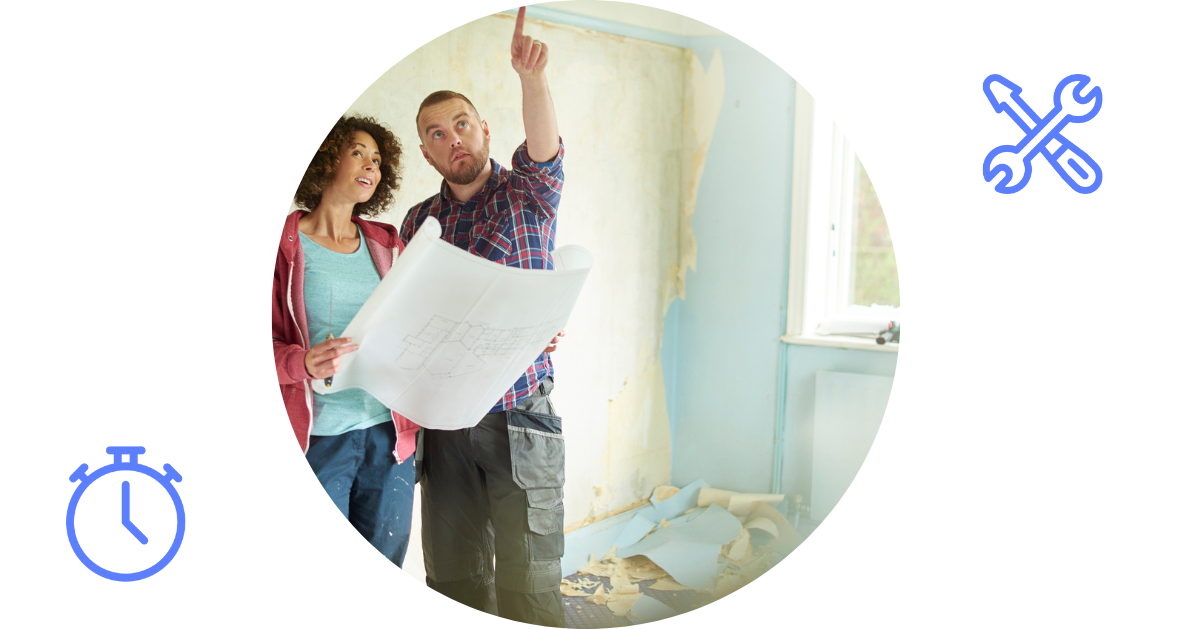How To Manage The Perfect Flip

House flipping may be America’s new favorite pastime.
Many are diving in thanks to HGTV’s approachable programming, shining a spotlight on seemingly effortless demolition efforts, painless remodeling, and an unchallenging resale process sure to bring real estate investors high purchase prices and limited financial risks.
The reality is a bit more complicated.
Don’t let The Property Brothers fool you. Flipping houses can be a complex process full of surprises that go far and above remedying shotty plumbing.
And if you don’t have the time, patience, or funds to cover those surprises – you may be looking at an investment property that will quickly deplete your bottom line.
But managing the perfect house flip is possible.

You just need to go in with the right expectations, the right skill set, and the right budget to make it happen.
And when it does? You may be looking at steady income, happy buyers, and a portfolio of projects that showcase your expertise at taking something from grime to great.
The good news? We’re here to show you just how to do it.
In this quick guide, we’ll cover:
House Flipping: The Fundamentals
House flipping is the process of purchasing a property, conducting renovations, and selling it for profit.
In an ideal state, a successful flip would reap enough gain to cover the cost of repairs, the original purchase price, and leave the real estate investor with enough extra to pocket in order to make the entire process worth it.
Then it’s rinse and repeat.
To maximize profits, the cardinal rule for house flippers is buy low and sell high.
This means, aim for a lower purchase price on that fixer-upper in order to increase your chances at selling for an amount that covers what you initially spent…and then some.
Another fundamental of the process? Turnaround time.
House flips should be completed as quickly as possible without sacrificing renovation quality.
Why is this such a vital component?
Consider all the costs that come with owning a home. From electricity to monthly mortgage payments – in this market? Homeownership doesn’t come cheap.
To avoid paying months and months of these costs – along with the extensive renovation bills that come with artful flips – you need to turn around and put that For Sale sign up as quickly as possible.

Considering jumping in? Better catch up on the most common mistakes of house flippers first.
Common Mistakes of House Flipping
The art of house flipping comes with a host of challenges you’ll encounter and a plethora of decisions to be made on the daily, ranging from which color of paint to buy to where will you ever get $20,000 more to patch the ceiling from the surprise bathroom leak.

We’ll say it again: house flipping isn’t for the faint of heart.
But a way you can try your hand at this real estate investment strategy with a little less risk? Come prepared.
Let’s break down some of the rookie mistakes that come with house flipping so you can be in the know and avoid common pitfalls.
- Prioritizing the house over the location. You want the worst house on the best street. Floor layouts, ugly kitchens, decaying bathrooms? That can all be fixed. Your property location can’t. Prioritize picking a property in the right location over what promises minimal work. Even the most gorgeous end-result residence needs to find a happy home with a willing buyer. That’s a steeper uphill climb if you’re fighting against low-ranking school districts and bad neighborhoods.
- Not choosing your contractor wisely. It’s not all about the bottom line. House flippers need to remember quality is what gets the highest purchase price. The National Association of Realtors recommends avoiding those contractors that will simply promise low costs and quick turnaround. Take the extra time to find a partner in this process who emphasizes high quality but understands timeliness is also a factor. Get estimates early so you can go in with firm estimates as to cost and schedule. Another tip? HGTV suggests taking contractors with you on tours of the property so you have a clearer idea as to your entire upfront cost before signing on the dotted line.
- Tackling big renos – without experience. We get it. You’ve retiled your bathroom, swapped out your kitchen hardware, and painted more rooms than you’d care to admit. Does that make you an expert in restorative plumbing and complex electrical? Not exactly. Attempting large-scale repairs solo without the necessary expertise can drive up costs when you have to call someone in after the fact to clean up your mess. Be realistic with your skill sets. If you don’t have a reno background – that’s okay! House flipping can still be in the cards for you. Just know what projects to tackle yourself and what to assign to a qualified contractor.
- Not being realistic with budget. Know your numbers and know your numbers early. Don’t wait until after you buy to realize you have too little left over to make necessary changes to the property. Know how much you have to buy with and make sure to evaluate potential future list prices to understand what your return may be. Get early quotes from contractors and go in as knowledgeable as possible. Yes, sometimes surprises occur. Have wiggle room in your budget to compensate, especially if this is one of your first flips.
- Not considering your timeline. While speed is a key component of successful flipping, taking the time to find the right property in the right neighborhood shouldn’t be rushed. Some properties are too far gone, located too far from good neighborhoods, and too unsalvageable for house flipping to be worth it. So, know where to go slow and where to speed up. Once that property is yours, aim for a turnaround in weeks or months. But before that, make sure to slow your schedule to find the right project property for you.
In-the-know on what to avoid? Good. Let’s dive into a quick guide on how to navigate house-flipping like a pro.
Our Step-By-Step Guide To House Flipping
Ready to wade into the real estate market and live out your own HGTV dreams?

Let’s break down how you can find success buying low, selling high, and maximizing your returns as you revitalize properties throughout your community.
Do Your Research
When is the right time to start house flipping? According to Architectural Digest, times of tighter inventory and higher demand are prime opportunities to get involved.
However, when prices for your starter property are sky-high, press pause and reevaluate. That may not give you the ultimate return you want. You don’t want to be loaded with high mortgage payments for a home that will still require significant renovation costs.
Aim for periods with lower interest rates, and make sure to do your homework on potential market fluctuations.
Find Your House
We’re doubling down on our earlier advice – you want the worst house on the best street.
Find prime neighborhoods with cemented value. Look for underlying factors that will keep purchase prices rising. New storefronts and restaurants opening nearby? Good schools?
Look up current or future city plans to check prioritization on improvement for the community. If new developments are in the works (think parks, road updates, etc.) – it demonstrates a commitment from the city to keep this neighborhood strong.

You may suspect sources such as the MLS and auctions may be good avenues to snag a fixer-upper for cheap. You’d be wrong.
MLS comes with a whirlwind of competition, and auctions can create environments in which it’s difficult to land a home at the lower price you want.
FSBO properties are great contenders, as are off-market options. We know that adds a few extra steps to the process, but this could easily be the difference between a successful flip…or a flop.
So, how do you find properties that haven’t hit the market just yet? Easy.
While you can drive through targeted neighborhoods and go door-to-door on properties that catch your eye – we have a more efficient and productive option.
Opt for data-driven lead generation platforms, like PropertyRadar, which harnesses the power of public records data to deliver expansive information on over 150 million properties nationwide.
Build customized lead lists of properties within your desired neighborhoods, applying your very own sets of criteria to ensure any results fit exactly what you’re looking for. Turn on monitoring and watch your lists automatically update when new properties and information that match become available.
Better yet? Effortlessly skip-trace each and every property on your list to contact owners directly via a number of outbound methods.
PropertyRadar also provides essential neighborhood comparables, in-depth community information, demographic insights, transaction histories, and more to set yourself and your future flipping team up for success.
Not convinced? Check out our 10 reasons why PropertyRadar needs to be your next essential real estate tool.
Buy For The Right Price
Found the right property? The next step is getting it for the right price.
It’s called the golden rule. Everyone wants it, and we’re here to break it down for you.
Otherwise known as the 70% rule, this approach dictates house flippers should not pay over 70% of what you believe the property’s ARV (after-repair-value) will be.
However, use this once-tried-and-true method with caution. With the current chaotic state of the real estate market, you don’t want to make a bid that’s too low. Instead, use it as a jumping off point, layering in additional relevant information, such as value of nearby properties and national interest rates.
Get Your Financing Locked Down
How exactly do you fund a flip? While you don’t need to be a millionaire, you do need to have access to capital.

You have multiple options here, including leveraging your savings and HELOCs.
Bank loans are another path, and house flippers have multiple to consider. Bridge loans and hard money loans, for example, may provide quick cash while giving a concrete timeline to sell within.
Not sure what’s right for you? Talk to your lender about the fine print of each, and make sure to come up with estimates on the amount desired and the timeline for listing.
Renovate
It’s time to get to work.

Throughout the renovation process, make sure to keep clear lines of communication open with your contractor and repair team. You need to make sure you’re sticking to an ideal timeline while also staying in-the-know around surprises and unexpected costs.
While we’ve already chatted about the importance of finding the right contractor – we’re here to provide another path to locating the one for you.
If you’re a PropertyRadar user, head into your account. Input your city, then navigate to “Quick Lists > Investor > Flippers.” This provides you with a concrete list of properties that have been recently flipped in your area.
While useful for gauging deals and evaluating profitability potential, you can also use it to look up recent sellers for these flipped homes. If not contractors themselves, they may be willing to share who they trust with the work if you outreach.
Not all will share their secrets, but for those that do, it’ll be worth it.
Sell Your Flip
While you’re welcome to sell the home yourself as an FSBO property, a real estate agent can unlock the power of the MLS for you, ensuring your flip is visible across this database and relevant other destinations (think Redfin, Zillow, etc.)
This brings more interested parties, more offers, and a higher end-result selling price.
.jpg?width=2121&height=1414&name=iStock-1449713294%20(1).jpg)
Looking for more information on everything and anything real estate investing?
Check out our comprehensive how-to-get-started investing guide — your ultimate playbook for kicking off your real estate investment journey.
Ready to unlock the power of 150 million properties? Get a free PropertyRadar trial and kick off your next house flip today.



